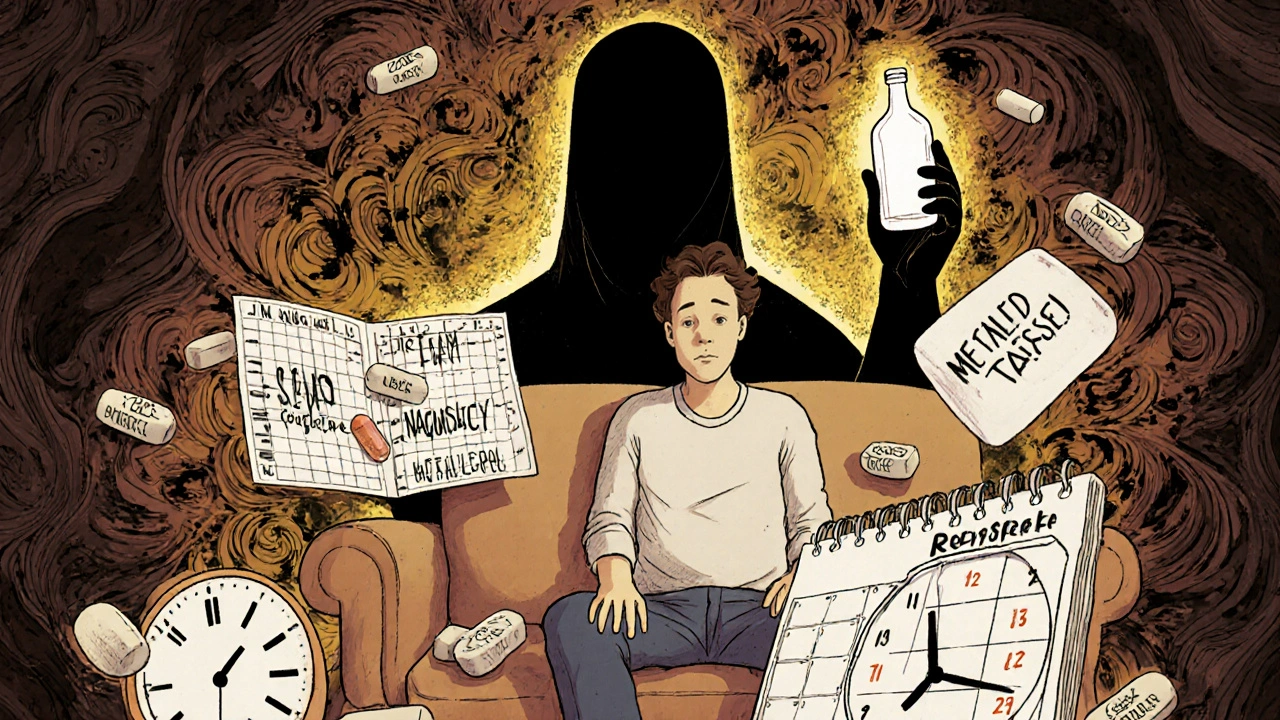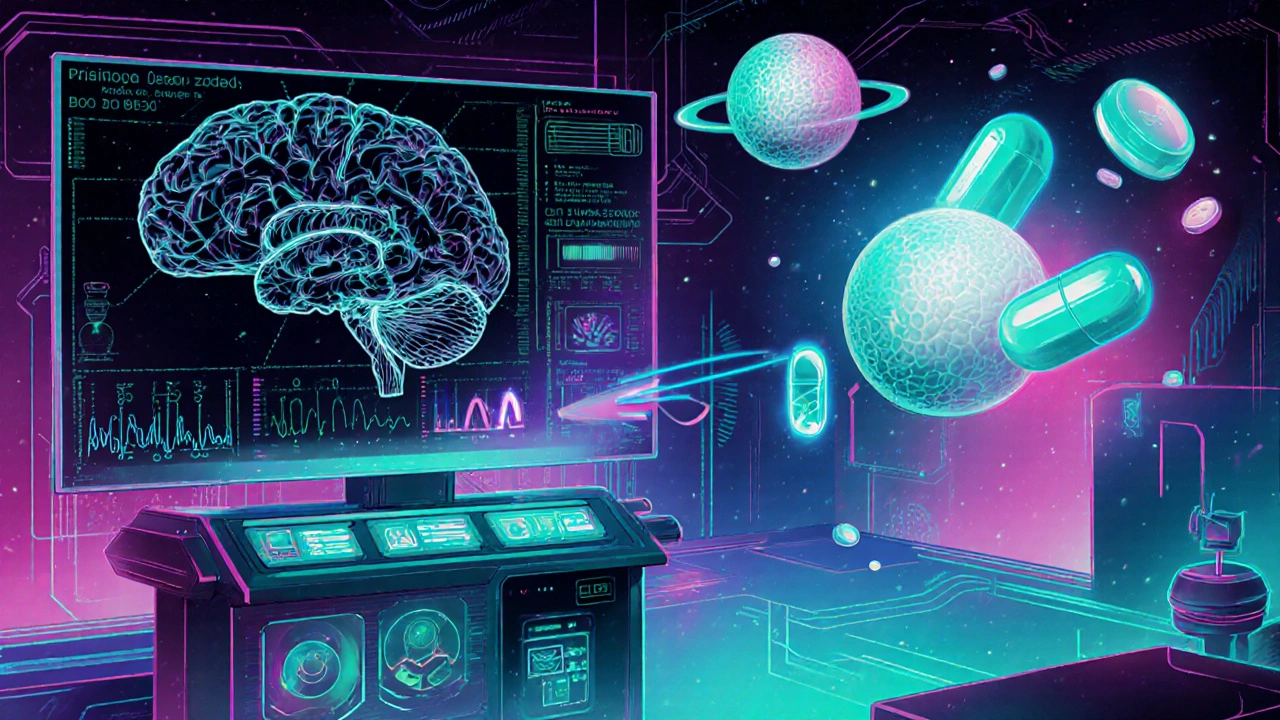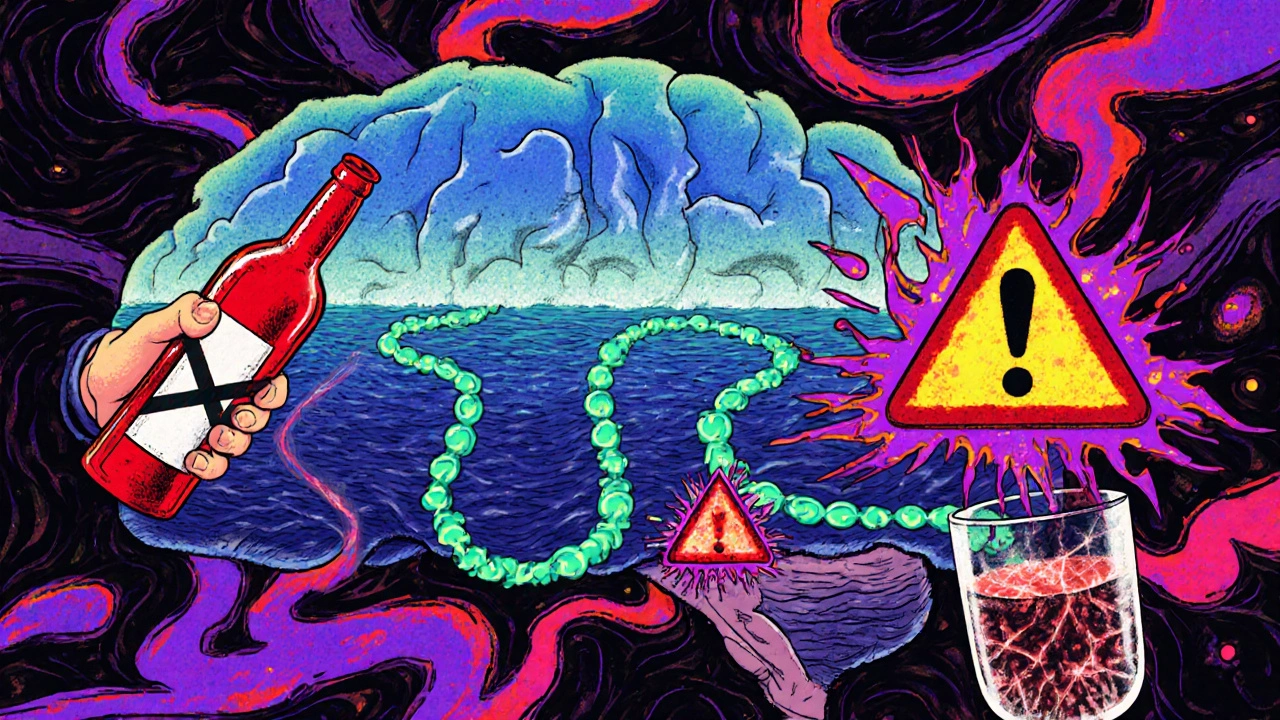When someone is trying to stop drinking, the hardest part isn’t always willpower - it’s the brain chemistry that keeps screaming for alcohol. Medications can help silence that noise. But here’s the truth most people don’t talk about: alcohol use disorder medications work only if they’re used right. Take them with alcohol? You could end up in the ER. Skip doses? Your risk of relapse shoots back up. And if you’re not matched to the right drug? It might do nothing at all.
How These Drugs Actually Work
There are three FDA-approved medications for alcohol use disorder, each with a different job. They don’t cure addiction. They don’t make you stop wanting to drink. They change how your brain reacts - and that’s enough to keep many people from going back to heavy drinking.Naltrexone blocks the part of your brain that gets rewarded when you drink. Think of it like turning off the pleasure button. You still might take a sip, but it doesn’t feel good anymore. That cuts down on heavy drinking episodes. A 2021 meta-analysis found oral naltrexone (50 mg daily) reduced relapse risk by 18% compared to placebo. The monthly shot, Vivitrol, works the same way - but you don’t have to remember to take it every day.
Acamprosate fixes the brain chaos after you stop drinking. Alcohol messes with your neurotransmitters - especially GABA and glutamate. When you quit, your brain doesn’t know how to calm down. Acamprosate helps restore balance. It’s not about stopping cravings. It’s about making life feel normal again after detox. People who’ve been sober for a few days and want to stay that way often do best with this one.
Disulfiram is the old-school option. It makes your body react badly to alcohol - flushing, nausea, pounding heart. It’s not a treatment. It’s a deterrent. You have to be scared of drinking for it to work. And if you’re not? You’ll just stop taking it. Still, for some people - highly motivated, with strong support - it’s the only thing that keeps them sober.
Who Gets the Best Results?
Not everyone responds the same way. Your history matters more than you think.If you’ve had severe withdrawal symptoms - seizures, hallucinations, delirium - gabapentin might be your best bet. A 2020 study showed 45% of people with high withdrawal symptoms stayed abstinent on gabapentin. Only 28% did on placebo. That’s a big difference. Gabapentin is also safer for people with liver disease, which is huge since many with AUD have damaged livers.
If your goal is total abstinence, acamprosate is the go-to. If you just want to cut back on binge drinking, naltrexone wins. Disulfiram? Only if you’re ready to live in fear of a single sip.
And here’s something no one tells you: timing matters. You can’t start acamprosate until you’ve been alcohol-free for 3-5 days. Naltrexone? You need to wait 7-10 days after your last opioid use - even if you’re not addicted to opioids. Some pain meds, cough syrups, even certain anti-diarrhea pills can trigger a dangerous reaction. Your doctor needs to know everything you’re taking.
The Real Problem: People Stop Taking Them
The science is solid. But in real life? Only 34% of people stay on their medication past three months.Why? Side effects. Cost. And confusion.
Acamprosate causes diarrhea in about 1 in 10 people. Naltrexone? Nausea, mostly. It’s mild, but enough to make someone quit. Disulfiram? Metallic taste, drowsiness, anxiety - and the fear that if you accidentally drink even a little (mouthwash, vanilla extract, fermented foods), you’ll get sick. That fear alone makes people stop.
Cost is another silent killer. Naltrexone and acamprosate cost $200-$400 a month. Even with insurance, copays add up. Disulfiram? $20 a month. But it’s the least prescribed. Why? Doctors are scared of it. And patients don’t trust it.
And here’s the kicker: most primary care doctors don’t feel trained to prescribe these drugs. SAMHSA says only 28% of them do. So patients get sent to specialists - and wait months. By then, the motivation’s gone.

What Happens If You Drink While on These Drugs?
This is where people get hurt.With naltrexone? You might not feel the high. That’s it. No danger. Just disappointment.
With acamprosate? Nothing dangerous. You might feel more anxious. But no physical reaction.
With disulfiram? That’s the emergency room. If you drink while on it, your body can’t break down alcohol. Acetaldehyde builds up. You get severe flushing, vomiting, chest pain, low blood pressure. In rare cases, it can be fatal. That’s why doctors spend 20 minutes explaining it - and why so many patients still end up in the ER.
And yes - it happens. People drink a glass of wine. Or take a sip of cocktail. Or use hand sanitizer. And then they panic. They don’t tell their doctor. They quit the meds. And relapse follows.
Combining Medications? Not Always Better
You might think: if one drug helps, two must be better. Not always.The COMBINE study - one of the largest ever on AUD treatment - gave 1,383 people either naltrexone, acamprosate, both, or neither. The result? Taking both together didn’t improve outcomes over taking just one. In fact, it increased side effects without adding benefit.
But another study of 250 people found combination therapy worked better than placebo - and better than acamprosate alone. So what’s the truth? It depends on the person. If you’ve tried one drug and failed, trying another might help. But stacking them? Don’t assume it’s the answer.

What’s New? The Future of Treatment
The field is changing fast.There’s now a compacted acamprosate pill - down from six a day to two. That’s huge for adherence.
Long-acting naltrexone implants - six-month doses - are in phase 2 trials. Early results show 78% adherence versus 42% for monthly shots. That could change everything.
And then there’s personalized medicine. A 2023 machine learning model used brain scans, genetics, and drinking patterns to match patients to the right drug with 82% accuracy. That’s not science fiction. It’s happening now.
Ketamine infusions? A 2022 study showed a 41% drop in relapse. Microbiome treatments? Lactobacillus and NAC reduced heavy drinking days by 37% in a small trial. These aren’t cures - but they’re new tools.
And digital tools? Apps that track cravings and send alerts when you’re at risk? One 2023 study showed they cut relapse risk by 33% when paired with medication.
What Should You Do?
If you’re trying to stop drinking:- Don’t assume one size fits all. Your history, your liver health, your motivation - they all matter.
- Ask your doctor: which medication fits me? Not what worked for someone else.
- Be honest about your drinking. Even one drink a week can affect your treatment.
- Know the side effects. If you get diarrhea on acamprosate, don’t quit. Talk to your doctor. Maybe it’s temporary.
- Don’t wait for perfection. If you miss a dose, don’t give up. Just get back on track.
- Combine meds with therapy. Medication alone is half the battle. Counseling, support groups, lifestyle changes - they’re the other half.
Alcohol use disorder isn’t a moral failure. It’s a medical condition. And like diabetes or hypertension, it often needs ongoing treatment. The drugs exist. The evidence is clear. The gap isn’t in science - it’s in access, understanding, and stigma.
You don’t need to be perfect. You just need to keep trying.
Can I drink alcohol while taking naltrexone?
Yes, you can - but it’s not recommended. Naltrexone blocks the pleasurable effects of alcohol, so drinking won’t feel good. You won’t get sick like you would with disulfiram. But drinking while on naltrexone reduces its effectiveness and increases your risk of relapse. The goal is to reduce drinking, not to test the limits.
Why is acamprosate only for people who are already abstinent?
Acamprosate works to stabilize brain chemistry after alcohol withdrawal. If you’re still drinking, your brain is still in chaos - and acamprosate can’t do its job. You need at least 3-5 days of complete abstinence before starting it. Trying to take it while drinking can make you feel worse - more anxious, nauseous - without helping.
Is disulfiram safe for people with liver disease?
No. Disulfiram is metabolized by the liver and can cause serious liver damage, especially in people with existing liver disease. It’s generally avoided in patients with cirrhosis or elevated liver enzymes. If you have alcohol-related liver damage, gabapentin or naltrexone are safer options - but always get liver function tests before starting any medication.
How long should I stay on AUD medication?
Most studies show benefits for 6-12 months, but alcohol use disorder is often a chronic condition. Many people need medication for years - even lifelong. Stopping too soon increases relapse risk. If you feel better, that’s a sign the medication is working, not that you’re cured. Talk to your doctor before stopping.
Are there cheaper alternatives to naltrexone and acamprosate?
Disulfiram is the cheapest - around $20-$50 a month. But it’s not safer or more effective for most people. Gabapentin, often used off-label, is also affordable and may be covered by insurance. Generic versions of naltrexone and acamprosate are available, but prices vary. Ask your pharmacy about patient assistance programs - many drugmakers offer free or low-cost options if you qualify.
Can I take these medications if I’m on antidepressants?
Yes - and you often should. Depression and alcohol use disorder commonly occur together. Naltrexone and acamprosate have no known dangerous interactions with SSRIs or SNRIs. In fact, treating both conditions at once improves outcomes. Always tell your doctor what you’re taking - including over-the-counter meds and supplements - to avoid rare interactions.
Why don’t more doctors prescribe these medications?
Many doctors weren’t trained in addiction medicine. They see AUD as a behavioral issue, not a medical one. There’s also stigma - both from providers and patients. Plus, prescribing requires time: assessing history, checking liver/kidney function, counseling on side effects. Most primary care visits are 15 minutes. That’s not enough. But change is coming - with more training programs and telehealth options making it easier to access specialists.

Kristen Magnes
Just wanted to say this post saved my life. I was on naltrexone for 6 months, quit because of nausea, then tried acamprosate and got the diarrhea thing - thought I was broken. Turned out my doctor didn’t tell me to start slow. Took half a pill for a week, then full dose. Now I’m 11 months sober. It’s not magic, but it’s medicine. And medicine doesn’t care if you’re perfect - it just wants you to show up.
adam hector
Let’s be real - alcoholism isn’t a disease, it’s a choice masked by pharmaceutical propaganda. These drugs just let people feel like they’re doing something while avoiding the real work: facing their trauma, their emptiness, their fear of being alone without the bottle. The brain doesn’t need fixing - it needs discipline. And discipline doesn’t come from a pill. It comes from staring into the mirror and saying, ‘I am not a victim.’
Ravi Singhal
bro i tried naltrexone and honestly it made me feel like a robot… like i could drink but nothing felt good? weird. also my cousin in delhi took disulfiram and accidentally had some fermented mango pickle and ended up in hospital 😅. why is this so hard? why cant we just… not drink? 🤔
Victoria Arnett
Anyone else notice how no one talks about gabapentin being used off label? I’ve been on it for 8 months and it’s the only thing that stopped my night sweats and anxiety after quitting. My doc shrugged and said ‘it’s not FDA approved’ like that’s the end of the story. But it works. Why are we ignoring what actually helps people?
HALEY BERGSTROM-BORINS
THEY’RE LYING TO YOU 😱
These meds are part of the Big Pharma cover-up 🏥💊
Did you know the FDA was pressured to approve naltrexone because of lobbying from opioid manufacturers? 🤫
And acamprosate? It’s just a placebo with fancy packaging.
They want you dependent on pills so you never question the system.
Also - hand sanitizer contains alcohol. THEY KNOW. THEY WANT YOU TO FAIL. 🌍👁️
Sharon M Delgado
As someone who’s lived this - I want to say thank you for writing this with such care. The part about timing? Yes. I started acamprosate too soon - three days in - and felt like I was being slowly poisoned. Waited five days. Everything changed. And the cost? I cried when I found out my pharmacy had a patient assistance program. It’s not about being ‘weak’ - it’s about being human. And humans need systems that see them.
Dr. Marie White
I’m a psychiatrist and I see this every week. The biggest barrier isn’t the meds - it’s the shame. People think if they’re taking medication, they’re ‘giving up’ on willpower. But addiction rewires the brain like diabetes rewires metabolism. You wouldn’t tell someone with Type 1 to ‘just stop needing insulin.’ So why do we say that about alcohol? The science is clear. The stigma is the real disease.
Wendy Tharp
So let me get this straight - you’re telling me it’s okay to rely on chemicals to avoid dealing with your life? Pathetic. If you can’t handle sobriety without a pill, maybe you’re not ready. Or maybe you’re just lazy. This isn’t cancer - it’s a moral failure dressed up in medical jargon. I’ve known people who quit cold turkey, no meds, no therapy - and they’re thriving. What’s your excuse?
Subham Das
One must contemplate the ontological paradox of pharmacological intervention in the realm of existential self-destruction - for when the human organism seeks chemical solace from the void of meaning, is it not the very structure of modernity - with its commodified relief, its institutionalized dependency - that has rendered the soul incapable of autonomous repair? The FDA-approved triad - naltrexone, acamprosate, disulfiram - are not cures, but palliative distractions, offering the illusion of agency while reinforcing the hegemony of the pharmaceutical-industrial complex. One must ask: who profits when the addict becomes a patient? And more crucially - who profits when the patient remains a patient?
Cori Azbill
USA is weak. In my country, people just quit. No pills. No therapy. Just grit. These meds are for people who want to be coddled. And don’t even get me started on ‘personalized medicine’ - that’s just tech bros trying to sell brain scans to desperate people. You don’t need AI to tell you to stop drinking. You need a spine. And America lost its spine in 2008.
Paul Orozco
Did anyone else notice the author didn’t mention the 12-step program once? That’s a red flag. AA has a 50% success rate. These drugs? 18% reduction in relapse. That’s not a win - that’s a failure disguised as progress. And why is there no mention of spiritual awakening? This is a moral crisis - not a chemical one. The real treatment is surrender. Not a prescription.
Bobby Marshall
Man, this hit different. I was on disulfiram for 3 months - hated the taste, scared to even eat pickles. But I kept going because I had a buddy who’d been sober 7 years and said, ‘It’s not about feeling good - it’s about staying alive.’ One day I drank a sip of wine at a wedding - panicked, called my doc, didn’t quit. Just reset. And now? I’ve got 18 months. Not because of magic pills. But because I stopped trying to be perfect. Just kept showing up. That’s all.
Ardith Franklin
There’s a reason these drugs are only prescribed to 28% of doctors - because they’re ineffective. The whole system is rigged. The ‘meta-analyses’? Funded by pharma. The ‘studies’? Small samples, cherry-picked results. They don’t want you sober - they want you on meds forever. Look at the stats: 34% stay on meds past 3 months. That’s not compliance - that’s a system designed to fail. Wake up. This isn’t treatment. It’s profit.